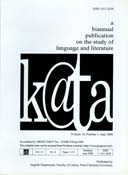Post-traumatic people in Paul Auster's The Book of Illusions from Cathy Caruth's and Michelle Balaev's perspectives
Abstract
In his novel The Book of Illusions, Paul Auster displays his knowledge not only as a writer, but also as a talented critic of cinema, painting and world literature. Opening up the question of identity after the loss, Auster presents the reader with the traumatic form of grief over the dead ones. The trauma which is portrayed in The Book of Illusions is the direct experience with death, with those who are left behind and for those who find death as the only solution for being forgiven. Strangely enough, while the main theme is death, Auster portrays the ways of resistance and the power of love to shape the process of post-traumatic identification. Precisely the aim here is to analyze Auster’s novel with the help of new theories that are introduced recently into the realm of literary criticism and trauma studies by Cathy Caruth and Michelle Balaev. By studying different opinions about loss and trauma and applying new perspectives, this research scrutinizes Austerian characters. Therefore there is a survey, a study of trauma from vantage points of traditional model theoreticians like Caruth and also pluralistic model argument represented by Balaev.
Keywords: Paul Auster; The Book of Illusions; Trauma Theory; Cathy Caruth; Michelle Balaev
Downloads
References
.
Balaev, M. (2012). The Nature of Trauma in American Novels. Evanston: Northwestern University Press.
Balaev, M. (2008). Trends in Literary Trauma Theory. Mosaic. vol. 41(2), 149-165.
Berge, A. M. K. (2005). The Narrated Self and Characterization: Paul Auster’s Literary Personae. Nordic Journal of English Studies. Vol. 4(1), 101-120.
Berger, J. (1997). Trauma and Literary Theory. Contemporary Literature. Vol. 38(3), 569-582.
Caruth, C. (1996). Unclaimed Experience: Trauma, Narrative, and History. Baltimore: John Hopkins Univeristy Press.
Deshmukh, P. (2014). “Then catastrophe strikes”: Reading Disaster in Paul Auster’s Novels and Autobiographies. Thesis of Doctor of Philosophy. Evanston: Northwestern University.
Dollimore, J. (2001). Death, Desire and Loss in Western Culture. New York: Routledge.
Freud, S. (2003). Beyond the Pleasure Principle and Other Writings. John Reddick (Trans.). London: Penguin Classics.
Lyčková, H. (2009). The Problem of Identity in Writing Paul Auster. MA Thesis. University of Masaryk.
Martin, B. (2008). Paul Auster’s Postmodernity. William E. Cain (Ed.). New York: Routledge. Print.
O’Donnell, P. (2010). The American Novel Now: Reading Contemporary American Fiction Since 1980. Chichester: Wiley-Blackwell.
Shostak, D. (2009). In the Country of Missing Persons: Paul Auster’s Narrative of Trauma. Studies in the Novel. Vol. 41(1), 66-87.
Spiers, T. (ED.). (2001). Trauma: A Practitioner’s Guide to Counselling. New York: Taylor and Francis Inc.
Thurschwell, P. (2000). Sigmund Freud. London: Routledge.
Shulga, E. (2013). Memory, History, Testimony: The Representation of Trauma in Iurii Dombrovskii’s and Vasilii Grossman’s Writing. Thesis of Doctor of Philosophy. London: University College London.

This work is licensed under a Creative Commons Attribution 4.0 International License.
This work is licensed under a Creative Commons Attribution License


















